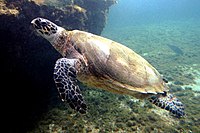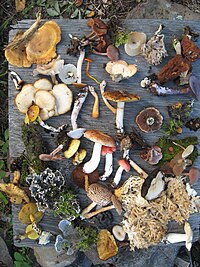
Genetic structure of the pink shrimp Penaeus (Farfantepenaeus) notialis (Pérez-Farfante, 1967) (Decapoda: Penaeidae) in the Colombian Caribbean
Sign Up to like & getrecommendations! Published in 2021 at "Fisheries Research"
DOI: 10.1016/j.fishres.2021.106052
Abstract: Abstract The pink shrimp Penaeus notialis is one of the most important commercial species of the world. In the Caribbean Sea of Colombia, they represent 70 % of the catches in industrial fisheries, but since… read more here.
Keywords: genetic structure; structure; shrimp penaeus; pink shrimp ... See more keywords

DNA barcoding, fisheries and communities: What do we have? Science and local knowledge to improve resource management in partnership with communities in the Colombian Caribbean
Sign Up to like & getrecommendations! Published in 2019 at "Marine Policy"
DOI: 10.1016/j.marpol.2018.08.025
Abstract: Abstract Human communities living around Cartagena Bay (Colombian Caribbean) depend on fishing activities as their main income and food source. This resource has been affected by pollution, sedimentation and overfishing. DNA barcoding was used for… read more here.
Keywords: genetic diversity; management; resource; colombian caribbean ... See more keywords

Where did this refuse come from? Marine anthropogenic litter on a remote island of the Colombian Caribbean sea
Sign Up to like & getrecommendations! Published in 2019 at "Marine Pollution Bulletin"
DOI: 10.1016/j.marpolbul.2019.110611
Abstract: Abstract On the Colombian continental shelf, 12 km SW of the municipality of Galerazamba, Department of Bolivar, is the northern-most island of the Colombian Caribbean: Isla Arena. Despite being remote and uninhabited, this island is being… read more here.
Keywords: anthropogenic litter; litter; colombian caribbean; island ... See more keywords

The invasive species Perna viridis (Linnaeus, 1758 - Bivalvia: Mytilidae) on artificial substrates: A baseline assessment for the Colombian Caribbean Sea.
Sign Up to like & getrecommendations! Published in 2020 at "Marine pollution bulletin"
DOI: 10.1016/j.marpolbul.2020.110926
Abstract: This baseline paper shows the Indo-Pacific mussel Perna viridis (Asian green mussel) inhabiting on floating plastic substrates in the Atlantico Department, as well as rafting on marine debris found at the Via Parque Isla de… read more here.
Keywords: invasive species; perna viridis; colombian caribbean; caribbean sea ... See more keywords

A matter of size: the population structure of the smallest known living shark, Etmopterus perryi (Springer & Burgess, 1985), from deep-waters off the Colombian Caribbean coast.
Sign Up to like & getrecommendations! Published in 2021 at "Journal of fish biology"
DOI: 10.1111/jfb.14755
Abstract: The dwarf lanternshark (Etmopterus perryi) is the smallest known described shark and practically no information has been available on this species since first described in the mid-1980s. Therefore, the aim of this work is to… read more here.
Keywords: length; smallest known; etmopterus perryi; colombian caribbean ... See more keywords

Perchlorate-Reducing Bacteria from Hypersaline Soils of the Colombian Caribbean
Sign Up to like & getrecommendations! Published in 2019 at "International Journal of Microbiology"
DOI: 10.1155/2019/6981865
Abstract: Perchlorate (ClO4−) has several industrial applications and is frequently detected in environmental matrices at relevant concentrations to human health. Currently, perchlorate-degrading bacteria are promising strategies for bioremediation in polluted sites. The aim of this study… read more here.
Keywords: bacteria hypersaline; perchlorate; colombian caribbean; hypersaline soils ... See more keywords

THE GENUS PLACOSPONGIA (DEMOSPONGIAE: CLIONAIDA) FROM THE COLOMBIAN CARIBBEAN.
Sign Up to like & getrecommendations! Published in 2023 at "Zootaxa"
DOI: 10.11646/zootaxa.5244.6.1
Abstract: The genus Placospongia Gray, 1867 is a group of sponges widely distributed in the world. It currently has 11 valid species, where five of those, Placospongia caribica Rützler et al., 2014, P. cristata Boury-Esnault, 1973,… read more here.
Keywords: placospongia demospongiae; genus placospongia; colombian caribbean; western atlantic ... See more keywords

Two new species of spionids from the genera Apoprionospio Foster, 1969 and Prionospio Malmgren, 1867 (Annelida: Spionidae) from the Colombian Caribbean.
Sign Up to like & getrecommendations! Published in 2023 at "Zootaxa"
DOI: 10.11646/zootaxa.5256.2.4
Abstract: Two species of genera Apoprionospio and Prionospio are described from the Colombian Caribbean. Apoprionospio sanguarensis sp. nov. and Prionospio gabriellae sp. nov. are new to science. Apoprionospio sanguarensis sp. nov. is distinguished from the three… read more here.
Keywords: genera apoprionospio; gabriellae nov; prionospio gabriellae; branchial pairs ... See more keywords

Biodiversity and Ecosystem Services Knowledge in the Colombian Caribbean
Sign Up to like & getrecommendations! Published in 2017 at "Tropical Conservation Science"
DOI: 10.1177/1940082917714229
Abstract: The Colombian Caribbean, one of the most biodiverse regions in the world, is facing great challenges in biodiversity conservation due to accelerated ecosystem transformations and the territorial planning required for peacemaking. We conducted a systematic… read more here.
Keywords: colombian caribbean; biodiversity; ecosystem services; biodiversity ecosystem ... See more keywords

Significant association between TaqI and FokI VDR gene polymorphisms and chronic spontaneous urticaria in a Colombian Caribbean population.
Sign Up to like & getrecommendations! Published in 2022 at "Allergologia et immunopathologia"
DOI: 10.15586/aei.v50isp2.696
Abstract: INTRODUCTION Chronic spontaneous urticaria (CSU) is an inflammatory skin disease related to poor quality of life. Previous studies have found that vitamin D deficiency and vitamin D receptor (VDR) TaqI, BsmI, FokI, and ApaI gene… read more here.
Keywords: vdr gene; taqi; foki; vdr ... See more keywords

Climatic factors and the incidence of dengue in Cartagena, Colombian Caribbean Region
Sign Up to like & getrecommendations! Published in 2022 at "Revista da Sociedade Brasileira de Medicina Tropical"
DOI: 10.1590/0037-8682-0072-2022
Abstract: ABSTRACT Background: The influence of climate on the epidemiology of dengue has scarcely been studied in Cartagena. Methods: The relationship between dengue cases and climatic and macroclimatic factors was explored using an ecological design and… read more here.
Keywords: incidence dengue; dengue cartagena; cartagena colombian; factors incidence ... See more keywords